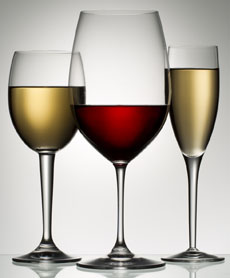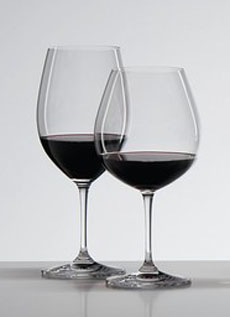TIP OF THE DAY: Wine Glass Types
 Ideally, you’ll have three wine-specific glasses for red, white and sparkling. Photo courtesy Brinvy.biz. |
“Why the different shapes and sizes of wine glasses?” writes a reader. “Can’t I just use one generic glass?” The bottom line is: You can serve wine in a juice glass, if that’s what you have. It’s how wine is served in many working class eateries the world over. Just as you can drink soup from a bowl or a mug, you can drink wine from a tea cup, a vessel used by some during Prohibition lest the neighbors spot them drinking alcohol. But for more elegant consumption that helps show off the qualities of the wine, three different shapes work best. Here’s why: Larger Bowl Wine Glasses For Red Wine Red wine glasses hold a minimum of 12 ounces. The wider bowl shape allows the wine to breathe more, opening up the flavors of red wine. Those balloon glasses at 24 ounces may look impressive and appeal to major imbibers; but they take extra space to store, extra care to wash, and are more showy than useful. |
|
|
Narrower Bowl Wine Glasses For White Wine White wine glasses range between 10 and 12 ounces. The shape’s narrower bowl helps to keep the wine cool longer. Champagne and other sparkling wines are best served in an 8- to 12-ounce flute. The narrow shape keeps the bubbles from dissipating quickly (which is exactly what happens in a Champagne coupe), and focuses the bubbles to rise in a festive display. In some better stemware lines, tiny dimples are etched into the bottom of the bowl, which produce more bubbles and help to improve the way it tastes. In fact, the added effervescence increases the volatile compounds that are released when the bubbles burst, enhancing the bouquet. |
||
|
The Science Of Stemware For some time, the design of the best wine glasses has been a matter of science. At Riedel, the pioneer in stemware engineering and the glass of choice among connoisseurs, the bowls are designed to show off the qualities of each style of wine, enhancing the flavors and aromas. It’s scientific, and it works (it’s easy to do a side-by-side comparison between Riedel and a generic glass). Stems. The stem length will vary based on the designer. While tall stems look elegant, they may not be the most comfortable to hold. Also consider if they will fit easily into your cabinet and, if you hope to wash them mechanically, your dishwasher. On a similar plane, novelty stems—in the shape of cubes or diamonds, for example—are not as easy to hold. Bowl designs. Avoid colors and designs. If you’re serious about wine, you need to be able to focus on the subtleties of its color. Engineering. Experts look for thinner glass and a lip that curves in slightly to focus the aroma. A final tip: Wine glasses should be filled only about two-thirds full, not to the brim. |
 Riedel engineers each glass to show of the quality of the varietal—Cabernet versus Zinfandel, for example. Photo courtesy Riedel USA. |
|
|
|
||